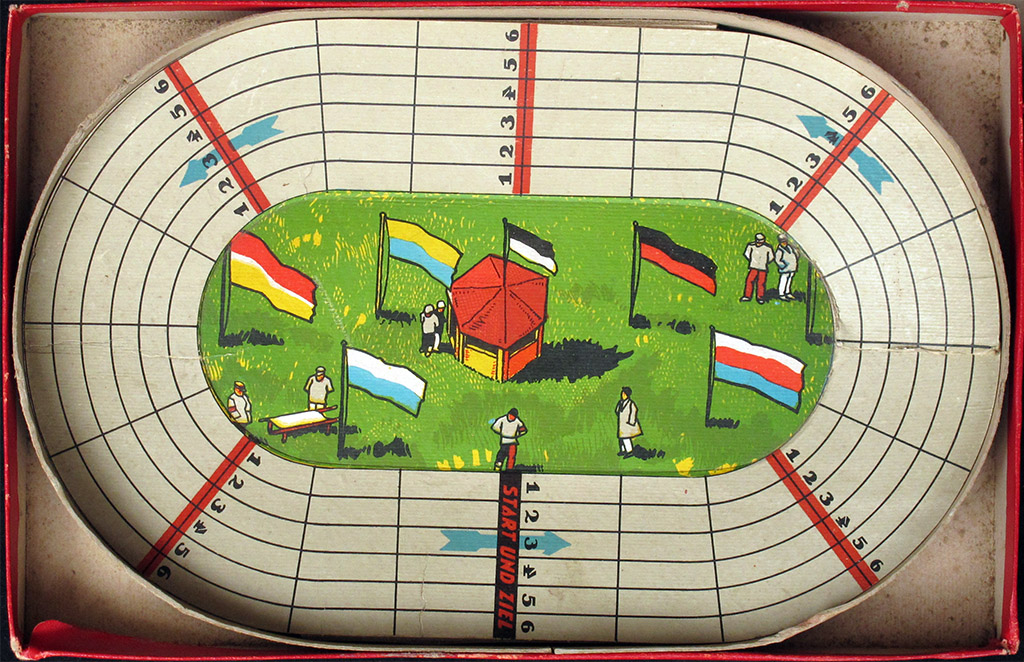
DIE RADRENNBAHN
Likuna, Germany, 1910s

Unusual German track cycling game of which, unfortunately, I do not have the rules nor much information about the game or about the game's maker. I admit I am not even sure if the fifth letter of the prominently featured makers name is an "n" (coud be an "r"?). For that matter, I am not even sure if that is the maker's name.
However, the flags displayed in this game may allow us to date it more accurately: on the box top we see two different flags (one of them twice). This flag that we see twice is the tricolour Imperial (Second Reich) flag, used until 1918, and briefly recovered as national flag between 1933 and 1935. The second flag (same colours, different order, white below) looks like the flag of the city of Berlin used between 1861 and 1912. (More on flags below).
So this game could have been made either before the First World War, or later by a nostalgic. Even though my first impression (by the touch-and-feel) was that the game was from the 1920s, now I think that the possibility that the game is older holds water. However, it is hard to say.
(Of course, the words "Gesetzlich Geschützt" written under the game's name mean "trademark registered" and have been used all throughout the XXth century. They do not help to date the game).

This game is quite small. The box measures 35 x 29 x 3 cm and the board, as you can see, fits inside the box. With only 20 squares, it is also one of the shortest velodromes in my collection.
The most outstanding feature of this game, though, is the cant in the track. There are not many games with canted velodromes. Not only are they more difficult to make, but the riders tend to fall.

I cannot identify the leftmost flag, but the rest are German states' flags. Clockwise: Braunschweig (yellow/blue), East Prussia (black/white), Württemberg (black/red), Schaumburg-Lippe (white/red/blue) and Bavaria (white/blue, still in use, but not used in the interwar period). All these flags were used in the Imperial (1871-1918) period, some of them were abandoned during the Weimar Republic (as is the case of the Bavarian flag), most of them are not used since 1945 (not the Bavarian flag, which was reinstated after WWII).
These flags reinforce the theory that the game was made before 1918, but some of these flags have been used by other regions at other moments (the yellow and blue flag was also used by the Prussian province of Upper Silesia -now belonging to Poland- between the wars), so my guesses may not be 100% accurate.UPDATE 2023: Siegfried L. remarks that the Braunschweig flag wasn't yellow-blue but blue-yellow. We cannot be sure whether this is the result of a careless illustrator or if it simply invalidates my theory about flags and the dating of the game. For lack of a better option, I will stick to my dating.

Inside the box I received the remains of three metal cyclists. I have not repaired them yet, but they are almost complete. I do not know if they belong to the game, since they do not look like velodrome riders in the first place. In fact, they look older than the rest of the game (even accounting for the game being from the 1910s).
However, my main objection is that I do not think they will stand on the canted curves when they are repaired. It was not easy to make even the base of the rider stand in the curve to take the picture below!

Canted curves are nice, but they do not help playability!

On the Giocchi dell Oca website there is a picture of very similar riders, which belong to the (older) English game Wheeling.
Thanks to Stefan Krug and Laisvydas Liaudanskas for the (independent) tips that allowed me to buy this one.
 |
 |
 |
 |
 |
|
CULTURE IDEAS |
TOTUM REVOLUTUM THUMBNAILS |
NAMES ALPHABETICAL |
CATEGORIES LISTS |
WHAT'S NEW BLOG |